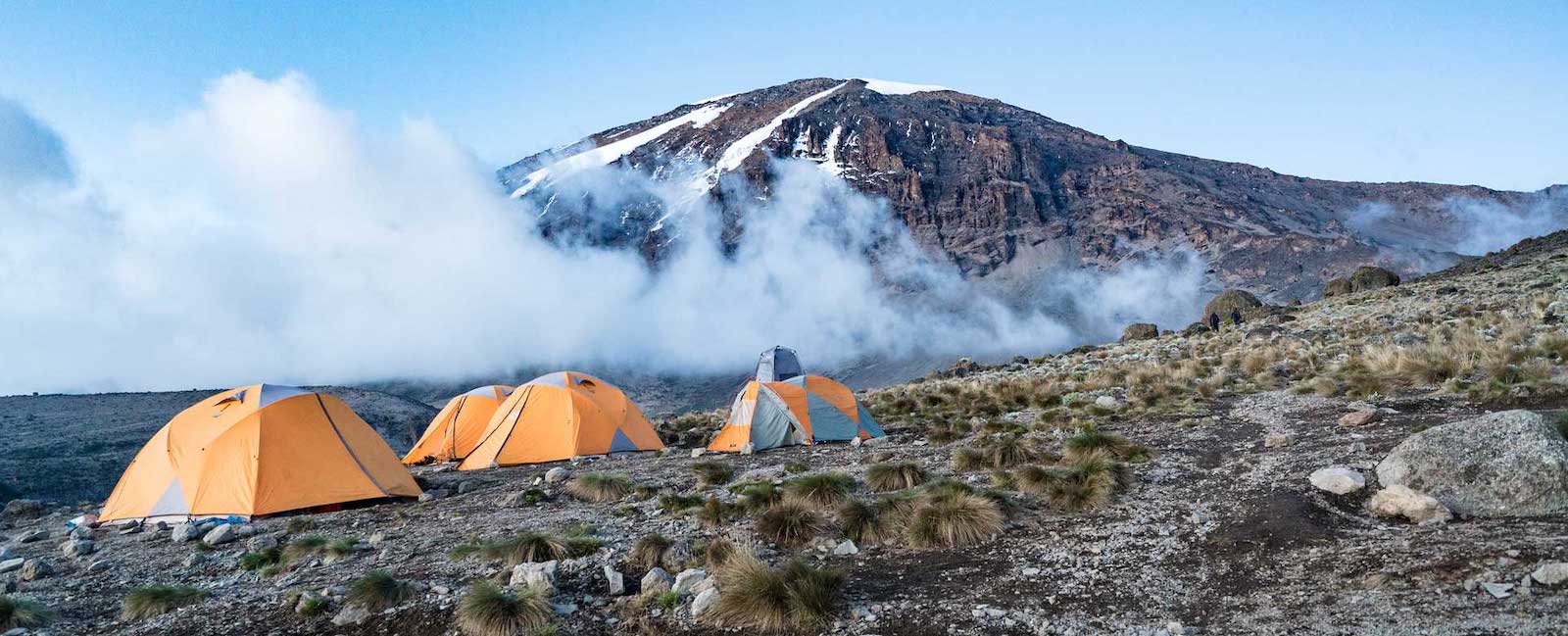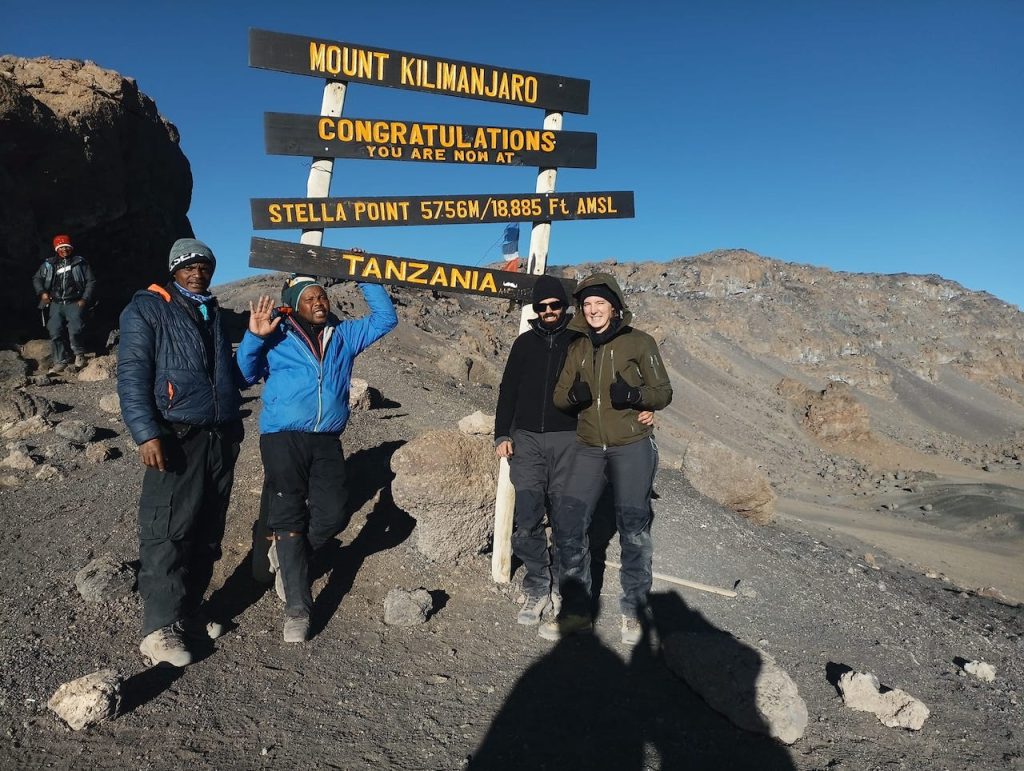Sample Machame Route Itinerary: 7 Days Machame Route
Climbing Mount Kilimanjaro through Machame Route is an adventure that will leave you with unforgettable memories. The route offers diverse landscapes, ever-changing vegetation sones, and the chance to push yourself to new heights—both physically and mentally. Below is an in-depth look at what each day will bring as you ascend the “Whiskey Route.”
Day 0: Touch down in Tanzania – Transfer to Arusha or Moshi
On arrival at Kilimanjaro International Airport (JRO), you will be picked up by your mountain guide himself, who will transfer you to your first lodge in Arusha where you will do a quick gear check and pre-climb briefing. Overnight at Planet Arusha Lodge or Chanya Lodge in Moshi.
Day 1: Machame Camp (Altitude: 9,350 ft / 2,850 m)
Hiking: 5-7 hours
Your Kilimanjaro journey begins with a short drive from Arusha or Moshi to the Machame Gate, where you’ll make a brief stop to register and other process to take place. The luggage is measured here to ensure that porters carry luggage according to the rules and regulations set by Kilimanjaro National Park Authorities.
As you leave the Machame Gate, the forest welcomes you. You will step into the lush montane forest and feel the excitement build. The path winds through moss-covered trees, and as you begin your ascent, the forest gradually opens up to reveal the stunning sights around you including birds and monkeys.
The hike today is moderate and perfect for warming up your legs. The air is fresh, the sounds of the forest surround you, and the sense of adventure is palpable. You’ll trek to Machame Camp, where you’ll have a well-deserved rest after a hearty dinner. Overnight is at the Machame Camp. All meals are included.
Day 2: Shira Plateau (Altitude: 12,500 ft / 3,810 m) : Machame Camp to Shira Camp
Hiking: 4-6 hours
Second day of your Kilimanjaro climb, and today, you’ll continue your ascent through the forest, but the landscape starts to shift a little bit. As the trees thin out, you’ll enter the moorland zone—a land of sweeping vistas, towering grasses, and giant lobelia plants. The climbing trail brings you closer to the magnificent Kibo peak, and the excitement builds as you get your first glimpses of the summit.
Lunch will be enjoyed on the way as you take in the panoramic views of Mount Kilimanjaro’s southern side. After lunch you will continue through the breathtaking Shira Plateau, a serene landscape that gives you a sense of just how vast this mountain truly is. Great views below and above!
The cool breeze and spectacular views make this an unforgettable day of trekking. Once you reach the Shira Camp, you will relax and later in the evening enjoy a freshly prepared dinner and sleep ready for the next day’s adventure.
Day 3: Barranco Camp (Altitude: 13,044 ft / 3,980 m) Hiking Shira to LavaTower and down to Barranco
Hiking: 6-8 hours
Today is the day for acclimatization—and one of the most exciting. Youw ill hike high and sleep low!
After breakfast, you’ll hike up to the Lava Tower, which sits at 15,190 feet (4,630 meters). This is an important acclimatization point, and although the day involves some uphill trekking, the effort will pay off in terms of altitude adjustment. Take your time and be enjoy the stunning landscapes along the way.
The Lava Tower, with its towering rock formations, stands as a monument to the power of nature. Once you reach the Lava Tower, you will take a break and enjoy lunch with an unparalleled view of the surroundings. After lunch and some rest, you will descend to Barranco Camp, where you’ll rest and prepare for the legendary Barranco Wall climb which happens tomorrow. The scenery today is diverse, from rocky desert to lush valleys—a perfect showcase of the mountain’s ecological zones.
Overnight today is at Barranco Camp.
Day 4: Karanga Camp (Altitude: 13,106 ft / 4,000 m) Barranco to Karanga Camp
Hiking: 4-5 hours
Early morning breakfast , then you start the day with the excitement brought by the anticipation of conquering the famous Barranco Wall which is scheduled for this day. While it looks intimidating at first, don’t let the steep cliff face deter you—this is one of the most memorable parts of the climb!
With a mix of scrambling, climbing, and steady pacing, you’ll make your way up the wall. Many climbers make the gesture of kissing the Barranco wall as the guides take photos for remembrance. As you approach the top, the views open up, revealing the vastness of the landscape below.
Once at the top, the trail flattens out and weaves through a series of ridges and valleys. The trekking becomes easier as you continue your way toward Karanga Camp, where you’ll settle in for the night.
The altitude is high at this point above 4000 meters above the sea level and therefore the air is thinner here, so take the time to hydrate and rest. This is another key acclimatization day—your body will thank you tomorrow as you continue to rise toward the summit.
You will enjoy freshly prepared dinner and stay overnight at Karanga Camp. All meals included.
Day 5: Barafu Camp (Altitude: 15,331 ft / 4,673 m); Trekking Karanga Camp to Barafu Camp
Hiking: 3-4 hours
This day is usually a relatively short one in terms of hiking, but it’s an essential one. You’ll begin by crossing over ridges and valleys that bring you closer to your final camp before summit day: Barafu Camp.
The climate becomes more arid as you near the high alpine zone, but the views are absolutely stunning. From here, you can already begin to see the summit of Kilimanjaro on the horizon—an inspiring sight for the final leg of your Kilimanjaro trek.
At Barafu Camp; the base camp for summiting Uhuru Peak, you’ll have a well-deserved rest. Dinner will be served early, and you’ll try to get some sleep before your midnight summit ascent. This is the time to gather your energy for the biggest challenge ahead: summiting Mount Kilimanjaro.
Day 6: Summit Day & Mweka Camp (Altitude: 19,341 ft / 5,895 m, then 10,500 ft / 3,200 m)
Hiking Barafu Camp – Uhuru peak (Summit) – Descend to Mweka Camp
Hiking: 6-7 hours up, 6-9 hours down
This is the moment that you have been waiting for; The summit day!
You’ll begin your hike at around midnight, using your headlamp to light the way as you slowly ascend toward Stella Point on the crater rim. The night air is cold, and the altitude will test your resolve, but the thought of standing atop Africa’s highest peak will keep you moving forward.
The summit push is demanding, but after a few hours of steady climbing, you’ll reach Stella Point, one of the points where climbers are rewarded by Kilimanjaro National Park Authority with a certificate. From there, it’s just a short trek to the summit, where the breathtaking views of the surrounding landscape and glaciers will make all the hard work worth it.
Arriving early in the morning at day break, you will take time to celebrate your success and take photos as the sun rises from the East. You can only stay a few minutes at the summit before starting your descent.
After celebrating at the summit, descend back down to Mweka Camp for your final night on the mountain. The descent is easier on the body, but still physically taxing. Take it slow and steady, as the famous saying on Mount Kilimanjaro reminds us always; ‘Pole Pole’. Remember to stay as hydrated as possible all the time.
Day 7: Mweka Gate Transfer to Arusha (Altitude: 5,000 ft / 1,524 m)
Hiking: 3-5 hours
This is the final day of your Kilimanjaro climb through Machame Route. It is a descent that takes you from Mweka Camp to the Mweka Gate. As you descend through the rainforest, the sounds of nature surround you, and you reflect on the incredible achievement you’ve just accomplished.
When you reach Mweka Gate, you’ll celebrate with your team, say your goodbyes, a moment which you will also use to tip your mountain crew which comprises of the head guide, assistant guide the cook and porters. Check out our Kilimanjaro tipping guide here.
You will take lunch at restaurant located in an art gallery not far from Mweka gate, then transfer in a car to Moshi or Kilimanjaro International Airport if departing on this day. If you want to go on a safari extension, we will take you to Arusha town where you will relax in readiness for your next adventure.
This 7-day Machame Route itinerary is not just a climb—it’s an extraordinary journey through some of the planet’s most diverse ecosystems, blending physical challenges with awe-inspiring beauty. Each day will push your limits, but the unparalleled reward of standing atop the summit makes it all worthwhile. Embrace every moment of this unforgettable adventure!


